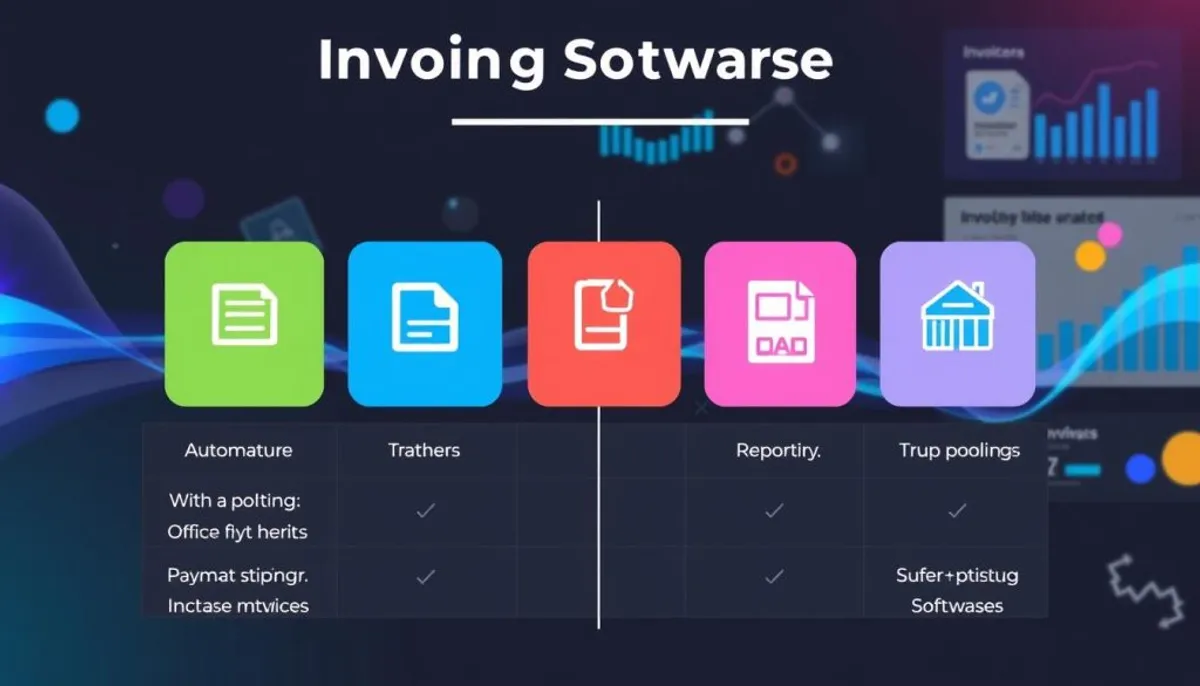Are you weary of the relentless pursuit of late payments and the drudgery of manual invoicing? Accounts receivable automation could be the transformative solution your enterprise requires. This advanced technology simplifies billing processes, minimizes errors, and enhances cash flow management. Let’s explore the realm of invoicing software and collections management to uncover the ideal solution for your organization.
The current market presents a plethora of AR automation options, catering to businesses of every scale. Whether you’re a small team or a large corporation, there exists a tailored solution to meet your specific requirements. These systems handle a spectrum of tasks, from basic collection needs to sophisticated reporting functionalities, liberating your team to focus on more strategic endeavors.

Did you know that certain AR automation tools can automate up to 80% of cash application tasks? HighRadius, for instance, can automatically align payments and remittances with open invoices, significantly reducing manual labor. With options like QuickBooks Online starting at just $35 per month, finding a solution that fits your budget is feasible.
Accounts receivable automation is revolutionizing financial management for businesses. It streamlines the tracking and collection of payments, boosting efficiency and precision in financial operations.
AR automation employs software to manage tasks such as invoice generation, payment processing, and data analysis. It supplants manual spreadsheets with digital solutions, diminishing human mistakes and accelerating cash flow forecasting. This technology automates customer billing, ensuring timely and precise invoices.
In today’s rapid business environment, AR automation is indispensable. It offers real-time visibility into all AR processes, empowering finance teams to make swift, informed decisions. This technology integrates smoothly with existing systems, fostering better cross-departmental collaboration and refining revenue recognition practices.
AR automation brings significant advantages:
By embracing AR automation, businesses can redirect their focus towards strategic endeavors, enhancing their financial health and unlocking growth opportunities.
Accounts receivable management is essential for maintaining a healthy cash flow. Despite its importance, businesses encounter numerous obstacles. We will examine the primary hurdles affecting credit control and debtors management.
Late payments significantly impact cash flow and financial stability. An astonishing 98% of C-level executives report that upper management is involved in invoice disputes and payment issues. This level of involvement highlights the gravity of the problem.
Many organizations continue to use outdated methods. Forty percent of finance leaders identify manual processes as their biggest hurdle in collecting payments. This inefficiency results in delays and errors in debtors management.
Accurate records are crucial for effective credit control. Manual data entry and reconciliation are error-prone. These inaccuracies can cause disputes, damaging customer relationships and slowing collections.
These challenges underscore the necessity for enhanced accounts receivable solutions. Businesses must implement efficient systems to improve credit control and streamline debtors management processes.
Modern accounts receivable management software brings a suite of essential features to streamline financial operations. These tools transform collections management, enabling businesses to track and collect payments with greater ease. This efficiency is crucial for maintaining a healthy cash flow.
Key features include:
Advanced AR software often incorporates AI for data extraction from contracts and documents. This enhances accuracy and minimizes manual input errors. Such technology significantly boosts the efficiency of billing and collections processes.
When selecting accounts receivable management software, businesses must consider their specific needs and budget. Options range from comprehensive solutions like Tabs and HighRadius for large enterprises to more tailored platforms like QuickBooks Online and Bill.com for small to medium-sized businesses.
Investing in robust AR software can lead to accelerated payment collection, reduced Days Sales Outstanding (DSO), and improved cash flow management. It’s a critical tool for businesses aiming to optimize their financial operations and support growth.
For businesses aiming for comprehensive accounts receivable management, all-in-one solutions are ideal. These platforms combine robust features within broader accounting systems, simplifying software integration. We will examine three notable options: QuickBooks Online, Xero, and FreshBooks.
QuickBooks Online is distinguished by its scalability and extensive integrations. It connects with over 750 apps, streamlining various business processes. This invoicing software also provides powerful cash flow forecasting tools, aiding businesses in making informed financial decisions.
Xero’s platform is celebrated for its user-friendly interface and unlimited user access. It integrates seamlessly with more than 1,000 third-party apps, enhancing its functionality. Xero’s invoicing software includes automated reminders and real-time bank feeds, improving cash flow management.
FreshBooks is designed for freelancers and small businesses with its intuitive design. Its invoicing software offers customizable templates and automatic payment reminders. FreshBooks also provides time tracking and expense management features, making it a versatile solution for growing businesses.

Large organizations with intricate accounts receivable demands necessitate sophisticated solutions. Enterprise-grade AR automation platforms provide advanced functionalities and scalability. They streamline financial operations and enhance revenue recognition.
HighRadius offers AI-driven accounts receivable automation tools. Their platform aims to diminish bad debt and elevate Days Sales Outstanding (DSO) for enterprises. It achieves high cash application automation rates through automated remittance aggregation, boosting efficiency in complex AR processes.
BlackLine delivers comprehensive reporting and analytics capabilities. Its platform offers deep financial insights, enabling businesses to make informed decisions. BlackLine’s AR automation tools integrate seamlessly with existing systems, providing a unified view of financial operations.
NetSuite combines robust Enterprise Resource Planning (ERP) functionality with integrated AR automation. This all-in-one solution streamlines financial processes, from invoicing to payment collection. NetSuite’s platform scales effortlessly, making it perfect for expanding enterprises.
These enterprise-grade platforms offer scalable solutions for organizations aiming to optimize their accounts receivable processes. By leveraging advanced technologies, businesses can enhance cash flow, decrease manual errors, and gain valuable insights into their financial performance.
Small businesses encounter distinct hurdles in managing accounts receivable. Specialized software can streamline customer billing and credit control processes. These tools are crafted to address the unique needs of smaller operations.
Stax Bill is tailored for subscription-based businesses. It offers automation tools for customer retention and revenue management. This software aids small companies in maintaining a steady cash flow from recurring payments.
Bill.com provides a user-friendly platform for both accounts receivable and payable management. Its competitive pricing makes it accessible for small businesses. The software facilitates easy tracking of invoices and payments.
Plooto stands out as a low-cost option with unlimited users. It’s ideal for small businesses looking to optimize their collection processes. Plooto automates payment reminders and offers multiple payment options to customers.
These specialized solutions can significantly enhance efficiency for small businesses. By automating tasks, they reduce errors and make financial records more accurate. This enables business owners to focus on growth rather than administrative tasks.
By selecting the appropriate AR solution, small businesses can enhance cash flow, diminish late payments, and fortify customer relationships. These tools empower small companies to compete more effectively in today’s fast-paced business environment.
Effective software for accounts receivable must integrate seamlessly with existing business systems. This integration is vital for streamlining operations and boosting overall efficiency in collections management.
AR software must harmonize with Enterprise Resource Planning (ERP) systems. This compatibility ensures real-time data exchange between financial modules, reducing manual data entry and minimizing errors. It facilitates synchronized updates across all connected platforms, offering a unified view of financial operations.
Integrating payment gateways with AR software streamlines online transactions. This feature enables customers to make payments directly through invoices, accelerating the collection process. It also provides real-time payment status updates, enhancing cash flow management and reducing follow-up efforts.
Open APIs are crucial for custom integrations with other business tools. They enable tailored solutions that meet specific business needs. API accessibility allows for the creation of automated workflows, linking AR processes with CRM systems, banking platforms, and other critical business applications.
By focusing on these integration capabilities, businesses can establish a robust AR ecosystem. This ecosystem enhances collections management efficiency and offers a seamless experience for both staff and customers.
The ti3 platform is a game-changer in accounts receivable management, introducing a novel method for collections management. It presents itself as a software as a service (SaaS) solution, directly confronting the hurdles of overdue accounts. This approach offers a streamlined payment process, a significant improvement over traditional methods.
Ti3’s automated reminder system ensures clients are always aware of their payment status. This feature significantly reduces the workload for AR teams, facilitating timely communication with customers. By automating reminders, businesses can maintain consistent follow-ups without overextending their resources.
The platform’s advanced automation extends to the entire collection process. Ti3 intelligently escalates issues and manages the flow of overdue accounts, enhancing efficiency in accounts receivable management. This systematic approach accelerates payment recovery, making it more reliable for businesses.

Distinguishing itself from traditional collection agencies, ti3 emphasizes the preservation of positive client relationships. Its approach is respectful and professional, balancing the urgency of payment with the value of customer satisfaction. This commitment to relationship preservation makes ti3 a standout in the collections management field.
Ti3 presents a cost-effective solution for businesses aiming to improve their accounts receivable management. It combines automation with a focus on client relationships, addressing key AR challenges while promoting positive interactions with clients.
When selecting accounts receivable automation software, one encounters a spectrum of pricing models. Small enterprises might discover entry-level options starting at $24 monthly. In contrast, large corporations often face custom pricing structures. It is imperative to balance the anticipated enhancements in AR processes against the costs of the software.
ROI considerations for accounts receivable automation encompass several aspects:
Many vendors offer tiered pricing models, contingent upon the features and number of users. This flexibility enables businesses to incrementally increase their investment as they expand. When assessing ROI, it is vital to examine how the software influences critical metrics such as accounts receivable aging and days sales outstanding.
Advanced AR solutions, incorporating AI for decision-making and cash flow forecasting, may demand a higher investment. These platforms promise substantial value by refining processes and delivering actionable insights. Through real-time data analysis, they forecast customer behavior, thus enhancing financial planning.
In conclusion, the optimal accounts receivable automation solution should streamline operations, elevate accuracy, and liberate resources for strategic endeavors. By meticulously evaluating your requirements and the prospective advantages, you can make a well-informed choice that enhances your financial performance.
In the realm of accounts receivable management, security and compliance are of utmost importance. Modern AR software solutions are equipped with advanced features to safeguard sensitive financial data. They also ensure adherence to regulatory requirements.
AR software utilizes cutting-edge encryption protocols to shield financial information. It employs secure data storage systems to prevent unauthorized access. Regular backups further safeguard against data loss. These measures are vital for the integrity of your credit control processes.
Leading AR solutions provide built-in compliance support for various industries and regulations. They assist businesses in adhering to financial regulations and data privacy laws, such as GDPR and PCI DSS. This is crucial for companies operating across multiple jurisdictions or handling international transactions.
Effective accounts receivable management hinges on proper access control. AR software enables businesses to establish granular user permissions. This ensures employees only access data necessary for their roles. Such a feature minimizes the risk of internal data breaches and maintains the confidentiality of sensitive financial information.
By focusing on these security and compliance features, businesses can ensure their accounts receivable processes remain secure and compliant with industry standards. This not only safeguards sensitive financial data but also fosters trust with clients and partners in the credit control ecosystem.
Embarking on the journey of accounts receivable automation software implementation necessitates meticulous planning and thorough user training. The successful integration of invoicing software is contingent upon a methodical approach. We will dissect the pivotal steps and considerations for a seamless implementation process.
A 10-step checklist serves as a roadmap for organizations navigating the implementation terrain:
Varied implementation methodologies, such as Agile, Waterfall, Phased Rollout, Big Bang, and Parallel Adoption, are available. Select the methodology that aligns with your organization’s objectives and capabilities.
Key stakeholders in the implementation phase include:
User training is paramount for unlocking the full potential of accounts receivable automation. Many vendors offer bespoke onboarding processes and dedicated account managers. The adoption of user-friendly interfaces, such as those found in FreshBooks and Zoho Books, can significantly ease the learning process.
Successful implementation yields tangible advantages. Organizations can anticipate expedited payment processing, enhanced working capital, and augmented productivity. With adequate implementation and training, accounts receivable automation can revolutionize financial operations.
Adopting software for accounts receivable is now essential for businesses seeking to optimize their financial processes. Midsize organizations, leveraging over 112 SaaS applications in 2024, recognize the transformative impact of accounts receivable management tools. These innovations can liberate teams from up to 60 hours of weekly invoice processing drudgery.
The advantages of AR automation transcend mere time savings. By introducing diverse payment options, companies can enhance conversion rates and prompt payment adherence. Automated alerts and data-driven customer segmentation further empower risk management, thus diminishing late payments and bad debt.
While automation significantly diminishes manual labor, the indispensable role of human expertise cannot be overstated. Accounting professionals continue to be crucial for data interpretation and financial oversight. Achieving a harmonious blend of automation and human insight can catalyze more efficient accounts receivable management. This synergy fosters improved cash flow and strengthens customer relationships.
As businesses mature, the selection of the appropriate software for accounts receivable becomes a critical decision. Evaluate factors such as integration capabilities, customization options, and industry-specific functionalities when choosing a solution. With the optimal tools in hand, organizations can revolutionize their financial operations, propelling overall business performance to unprecedented levels.